Research on 3D Localization of Indoor UAV Based on Wasserstein GAN and Pseudo Fingerprint Map
Abstract
:1. Introduction
- (1)
- In the offline phase, the WGAN algorithm is used to supplement and complement the data in a coarse-grained fingerprint database. The generator and discriminator are trained using the initial RSS dataset, and the synthesized RSS data are generated using the generator and fed into the discriminator along with the real data for adversarial training. During the training process, the weights of the generator and discriminator are adjusted so that they are balanced. The feasibility and effectiveness of the proposed method are verified by algorithm derivation and simulation test.
- (2)
- In an indoor environment where UAVs are operating, the 3D spatial volume is divided into small cubic cells, with each cell serving as a collection point for fingerprint data. The enhanced fingerprint database generated by WGAN is then used in the UAV localization system. In addition to using the RSS value of Wi-Fi, it relies on the inertial measurement unit (IMU) system of the UAV to revise 3D position coordinates in localization, which avoids the defect that visual localization is easily blocked in indoor environments.
- (3)
- In the online localization stage, the PFM generated by the WGAN-IM is used for matching and positioning. The generator takes a single set of RSS values as input to locate the target and produces multiple sets of similar RSS values as output. The discriminator takes a set of RSS values as input and outputs a ratio indicating the probability that the input data are real. The Wasserstein distance (W-distance) is used as the loss function of the generator, so that the distribution of the generated data is close to the distribution of the offline fingerprint database. By training the generator and discriminator, the generator can generate data similar to real offline fingerprint data. The gradient clipping technique is used to ensure the stability of the Wasserstein distance during training. In this way, the point location of the target is extended to plane matching, and the experimental results show that this method improves the localization accuracy.
2. Materials and Methods
2.1. Current Research on UAV Indoor Localization Systems
2.2. WGAN in Data Imputation
3. UAV Indoor Localization System
3.1. Three-Dimensional Spatial Fingerprint Division
3.2. IMU-Assisted UAV Localization System
4. The Role of the WGAN Algorithm in Offline and Online Phases
4.1. Enhanced Fingerprint Database with WGAN
4.2. Application of WGAN-IM in Online Localization Phase
5. Simulation Design and Results Analysis
5.1. Simulation of Scenario 1
5.1.1. Simulation Setup
5.1.2. Analysis of Simulation Results
5.2. Simulation of Scenario 2
5.2.1. Simulation Setup
5.2.2. Results of Scenario 2
6. Conclusions
Author Contributions
Funding
Data Availability Statement
Acknowledgments
Conflicts of Interest
References
- Gu, X.; Zheng, C.; Li, Z.; Zhou, G.; Zhou, H.; Zhao, L. Cooperative Localization for UAV Systems From the Perspective of Physical Clock Synchronization. IEEE J. Sel. Areas Commun. 2023, 42, 21–33. [Google Scholar] [CrossRef]
- Yuan, B.; He, R.; Ai, B.; Chen, R.; Zhang, H.; Liu, B. UAV-Assisted Localization Based on Joint TOA-RSS NLOS Identification. IEEE Commun. Lett. 2023, 28, 63–67. [Google Scholar] [CrossRef]
- Shu, Y.; Xu, P.; Niu, X.; Chen, Q.; Qiao, L.; Liu, J. High-rate attitude determination of moving vehicles with GNSS: GPS, BDS, GLONASS, and Galileo. IEEE Trans. Instrum. Meas. 2022, 71, 1–13. [Google Scholar] [CrossRef]
- Ahadi, M.; Kaltenberger, F. 5GNR Indoor Positioning By Joint DL-TDoA and DL-AoD. In Proceedings of the 2023 IEEE Wireless Communications and Networking Conference (WCNC), Glasgow, UK, 26–29 March 2023. [Google Scholar]
- Bach, S.-H.; Yi, S.-Y. Constrained Least-Squares Trilateration for Indoor Positioning System Under High GDOP Condition. IEEE Trans. Ind. Inform. 2023, 20, 4550–4558. [Google Scholar] [CrossRef]
- Ng, P.C.; Spachos, P.; She, J.; Plataniotis, K.N. A Kernel Method to Nonlinear Location Estimation With RSS-Based Fingerprint. IEEE Trans. Mob. Comput. 2022, 22, 4388–4404. [Google Scholar] [CrossRef]
- Sadhukhan, P.; Dahal, K.; Das, P.K. A Novel Weighted Fusion Based Efficient Clustering for Improved Wi-Fi Fingerprint Indoor Positioning. IEEE Trans. Wirel. Commun. 2022, 22, 4461–4474. [Google Scholar] [CrossRef]
- Li, Y.; Shu, F.; Shi, B.; Cheng, X.; Song, Y.; Wang, J. Enhanced RSS-Based UAV Localization Via Trajectory and Multi-Base Stations. IEEE Commun. Lett. 2021, 25, 1881–1885. [Google Scholar] [CrossRef]
- Moon, J.; Laoudias, C.; Guan, R.; Kim, S.; Zeinalipour-Yazti, D.; Panayiotou, C.G. Cramér–Rao Lower Bound Analysis of Differential Signal Strength Fingerprinting for Crowdsourced IoT Localization. IEEE Internet Things J. 2023, 10, 9690–9702. [Google Scholar] [CrossRef]
- Yang, J. Indoor Localization System Using Dual-Frequency Bands and Interpolation Algorithm. IEEE Internet Things J. 2020, 7, 11183–11194. [Google Scholar] [CrossRef]
- Gufran, D.; Pasricha, S. FedHIL: Heterogeneity Resilient Federated Learning for Robust Indoor Localization with Mobile Devices. ACM Trans. Embed. Comput. Syst. 2023, 22, 1–24. [Google Scholar] [CrossRef]
- Zhang, L.; Wu, S.; Zhang, T.; Zhang, Q. Learning to Locate: Adaptive Fingerprint-Based Localization with Few-Shot Relation Learning in Dynamic Indoor Environments. IEEE Trans. Wirel. Commun. 2023, 22, 5253–5264. [Google Scholar] [CrossRef]
- Huang, B.; Xu, Z.; Jia, B.; Mao, G. An Online Radio Map Update Scheme for WiFi Fingerprint-Based Localization. IEEE Internet Things J. 2019, 6, 6909–6918. [Google Scholar] [CrossRef]
- Zhu, X.; Qu, W.; Qiu, T.; Zhao, L.; Atiquzzaman, M.; Wu, D.O. Indoor intelligent fingerprint-based localization: Principles, approaches and challenges. IEEE Commun. Surv. Tutor. 2020, 22, 2634–2657. [Google Scholar] [CrossRef]
- Nabati, M.; Ghorashi, S.A. A real-time fingerprint-based indoor positioning using deep learning and preceding states. Expert Syst. Appl. 2023, 213, 118889. [Google Scholar] [CrossRef]
- Nabati, M.; Ghorashi, S.A.; Shahbazian, R. Joint Coordinate Optimization in Fingerprint-Based Indoor Positioning. IEEE Commun. Lett. 2020, 25, 1192–1195. [Google Scholar] [CrossRef]
- Liu, X.-Y.; Wang, X. Real-Time Indoor Localization for Smartphones Using Tensor-Generative Adversarial Nets. IEEE Trans. Neural Networks Learn. Syst. 2020, 32, 3433–3443. [Google Scholar] [CrossRef]
- Li, Q.; Qu, H.; Liu, Z.; Zhou, N.; Sun, W.; Sigg, S.; Li, J. AF-DCGAN: Amplitude Feature Deep Convolutional GAN for Fingerprint Construction in Indoor Localization Systems. IEEE Trans. Emerg. Top. Comput. Intell. 2019, 5, 468–480. [Google Scholar] [CrossRef]
- Creswell, A.; White, T.; Dumoulin, V.; Arulkumaran, K.; Sengupta, B.; Bharath, A.A. Generative Adversarial Networks: An Overview. IEEE Signal Process. Mag. 2018, 35, 53–65. [Google Scholar] [CrossRef]
- Saxena, D.; Cao, J. Generative adversarial networks (GANs) challenges, solutions, and future directions. ACM Comput. Surv. (CSUR) 2021, 54, 1–42. [Google Scholar] [CrossRef]
- Bond-Taylor, S.; Leach, A.; Long, Y.; Willcocks, C.G. Deep generative modelling: A comparative review of vaes, gans, normalizing flows, energy-based and autoregressive models. IEEE Trans. Pattern Anal. Mach. Intell. 2022, 44, 7327–7347. [Google Scholar] [CrossRef]
- Zou, H.; Chen, C.-L.; Li, M.; Yang, J.; Zhou, Y.; Xie, L.; Spanos, C.J. Adversarial Learning-Enabled Automatic WiFi Indoor Radio Map Construction and Adaptation With Mobile Robot. IEEE Internet Things J. 2020, 7, 6946–6954. [Google Scholar] [CrossRef]
- Wei, W.; Yan, J.; Wan, L.; Wang, C.; Zhang, G.; Wu, X. Enriching indoor localization fingerprint using a single AC-GAN. In Proceedings of the 2021 IEEE Wireless Communications and Networking Conference (WCNC), Nanjing, China, 29 March–1 April 2021. [Google Scholar]
- Chen, K.M.; Chang, R.Y. Semi-supervised learning with GANs for device-free fingerprinting indoor localization. In Proceedings of the GLOBECOM 2020—2020 IEEE Global Communications Conference, Taipei, Taiwan, 7–11 December 2020. [Google Scholar]
- Junoh, S.A.; Pyun, J.-Y. Enhancing Indoor Localization With Semi-Crowdsourced Fingerprinting and GAN-Based Data Augmentation. IEEE Internet Things J. 2023, 11, 11945–11959. [Google Scholar] [CrossRef]
- Arjovsky, M.; Chintala, S.; Bottou, L. Wasserstein generative adversarial networks. In Proceedings of the 34th International Conference on Machine Learning, Sydney, Australia, 6–11 August 2017. [Google Scholar]
- Gamagedara, K.; Lee, T.; Snyder, M. Quadrotor State Estimation With IMU and Delayed Real-Time Kinematic GPS. IEEE Trans. Aerosp. Electron. Syst. 2021, 57, 2661–2673. [Google Scholar] [CrossRef]
- Couturier, A.; Akhloufi, M.A. A review on absolute visual localization for UAV. Robot. Auton. Syst. 2020, 135, 103666. [Google Scholar] [CrossRef]
- He, Y.; Wang, W.; Mottola, L.; Li, S.; Sun, Y.; Li, J.; Jing, H.; Wang, T.; Wang, Y. Acoustic Localization System for Precise Drone Landing. IEEE Trans. Mob. Comput. 2023, 23, 4126–4144. [Google Scholar] [CrossRef]
- Wu, Y.; Li, Y.; Li, W.; Li, H.; Lu, R. Robust Lidar-Based Localization Scheme for Unmanned Ground Vehicle via Multisensor Fusion. IEEE Trans. Neural Networks Learn. Syst. 2020, 32, 5633–5643. [Google Scholar] [CrossRef]
- Famili, A.; Stavrou, A.; Wang, H.; Park, J.-M. iDROP: Robust Localization for Indoor Navigation of Drones With Optimized Beacon Placement. IEEE Internet Things J. 2023, 10, 14226–14238. [Google Scholar] [CrossRef]
- Sun, Y.; Wang, W.; Mottola, L.; Zhang, J.; Wang, R.; He, Y. Indoor Drone Localization and Tracking Based on Acoustic Inertial Measurement. IEEE Trans. Mob. Comput. 2023, 23, 7537–7551. [Google Scholar] [CrossRef]
- Famili, A.; Stavrou, A.; Wang, H.; Park, J.M. Pilot: High-precision indoor localization for autonomous drones. IEEE Trans. Veh. Technol. 2023, 72, 6445–6459. [Google Scholar] [CrossRef]
- Chhikara, P.; Tekchandani, R.; Kumar, N.; Chamola, V.; Guizani, M. DCNN-GA: A Deep Neural Net Architecture for Navigation of UAV in Indoor Environment. IEEE Internet Things J. 2020, 8, 4448–4460. [Google Scholar] [CrossRef]
- Vanhie-Van Gerwen, J.; Geebelen, K.; Wan, J.; Joseph, W.; Hoebeke, J.; De Poorter, E. Indoor drone positioning: Accuracy and cost trade-off for sensor fusion. IEEE Trans. Veh. Technol. 2022, 71, 961–974. [Google Scholar] [CrossRef]
- Song, Y.; Hsu, L.-T. Tightly coupled integrated navigation system via factor graph for UAV indoor localization. Aerosp. Sci. Technol. 2021, 108, 106370. [Google Scholar] [CrossRef]
- Kayhani, N.; Zhao, W.; McCabe, B.; Schoellig, A.P. Tag-based visual-inertial localization of unmanned aerial vehicles in indoor construction environments using an on-manifold extended Kalman filter. Autom. Constr. 2022, 135, 104112. [Google Scholar] [CrossRef]
- Lin, H.-Y.; Zhan, J.-R. GNSS-denied UAV indoor navigation with UWB incorporated visual inertial odometry. Measurement 2023, 206, 112256. [Google Scholar] [CrossRef]
- Fakhreddine, A.; Raffelsberger, C.; Sende, M.; Bettstetter, C. Experiments on drone-to-drone communication with wi-fi, lte-a, and 5g. In Proceedings of the 2022 IEEE Globecom Workshops (GC Wkshps), Rio de Janeiro, Brazil, 4–8 December 2022; pp. 904–909. [Google Scholar]
- Batra, A.; Abbas, A.A.; Sánchez-Pastor, J.; El-Absi, M.; Jiménez-Sáez, A.; Khaliel, M.; Barowski, J.; Wiemeler, M.; Göhringer, D.; Rolfes, I.; et al. Millimeter Wave Indoor SAR Sensing Assisted With Chipless Tags-Based Self-Localization System: Experimental Evaluation. IEEE Sensors J. 2023, 24, 844–857. [Google Scholar] [CrossRef]
- Xu, S.; Zhang, L.; Wang, X.; Chen, J.; Wei, F.; Wu, Y. Indoor Cooperative Localization for a Swarm of Micro UAVs Based on Visible Light Communication. IEEE Syst. J. 2023, 17, 6504–6515. [Google Scholar] [CrossRef]
- Onishi, Y.; Watanabe, H.; Nakamura, M.; Hashizume, H.; Sugimoto, M. Indoor Drone 3D Tracking Using Reflected Light from Floor Surfaces. IEEE J. Indoor Seamless Position. Navig. 2024, 2, 251–262. [Google Scholar] [CrossRef]
- Liu, X.; Ye, S.; Fiumara, G.; De Meo, P. Influence Nodes Identifying Method via Community-Based Backward Generating Network Framework. IEEE Trans. Netw. Sci. Eng. 2023, 11, 236–253. [Google Scholar] [CrossRef]
- Engelmann, J.; Lessmann, S. Conditional Wasserstein GAN-based oversampling of tabular data for imbalanced learning. Expert Syst. Appl. 2021, 174, 114582. [Google Scholar] [CrossRef]
- Fan, J.; Yuan, X.; Miao, Z.; Sun, Z.; Mei, X.; Zhou, F. Full attention Wasserstein GAN with gradient normalization for fault diagnosis under imbalanced data. IEEE Trans. Instrum. Meas. 2022, 71, 3517516. [Google Scholar] [CrossRef]
- Mi, J.; Ma, C.; Zheng, L.; Zhang, M.; Li, M.; Wang, M. WGAN-CL: A Wasserstein GAN with confidence loss for small-sample augmentation. Expert Syst. Appl. 2023, 233, 120943. [Google Scholar] [CrossRef]
- Luo, C.; Li, X.; Ye, Y.; Feng, S.; Ng, M.K. Experimental Study on Generative Adversarial Network for Precipitation Nowcasting. IEEE Trans. Geosci. Remote Sens. 2022, 60, 1–20. [Google Scholar] [CrossRef]
- Bousmina, A.; Selmi, M.; Ben Rhaiem, M.A.; Farah, I.R. A Hybrid Approach Based on GAN and CNN-LSTM for Aerial Activity Recognition. Remote Sens. 2023, 15, 3626. [Google Scholar] [CrossRef]
- Xu, S.; Xu, X.; Gao, H.; Xiao, F. TLS-WGAN-GP: A Generative Adversarial Network Model for Data-Driven Fault Root Cause Location. IEEE Trans. Consum. Electron. 2023, 69, 850–861. [Google Scholar] [CrossRef]
- Liu, H.; Gu, X.; Samaras, D. Wasserstein GAN with quadratic transport cost. In Proceedings of the IEEE/CVF International Conference on Computer Vision, Seoul, Republic of Korea, 27 October–2 November 2019; pp. 4832–4841. [Google Scholar]
- Xia, W.; Zhang, Y.; Yang, Y.; Xue, J.-H.; Zhou, B.; Yang, M.-H. Gan inversion: A survey. IEEE Trans. Pattern Anal. Mach. Intell. 2022, 45, 3121–3138. [Google Scholar] [CrossRef]
- Creswell, A.; Bharath, A.A. Inverting the generator of a generative adversarial network. IEEE Trans. Neural Netw. Learn. Syst. 2018, 30, 1967–1974. [Google Scholar] [CrossRef]
- Yang, N.; Zhou, M.; Xia, B.; Guo, X.; Qi, L. Inversion Based on a Detached Dual-Channel Domain Method for StyleGAN2 Embedding. IEEE Signal Process. Lett. 2021, 28, 553–557. [Google Scholar] [CrossRef]
- Sobehy, A.; Renault, É.; Mühlethaler, P. CSI-MIMO: K-nearest neighbor applied to indoor localization. In Proceedings of the ICC 2020—2020 IEEE International Conference on Communications (ICC), Dublin, Ireland, 7–11 June 2020; pp. 1–6. [Google Scholar]
- Bharadwaj, R.; Alomainy, A.; Koul, S.K. Experimental investigation of body-centric indoor localization using compact wearable antennas and machine learning algorithms. IEEE Trans. Antennas Propag. 2021, 70, 1344–1354. [Google Scholar] [CrossRef]
- Ngamakeur, K.; Yongchareon, S.; Yu, J.; Sheng, Q.Z. Deep CNN-LSTM Network for Indoor Location Estimation Using Analog Signals of Passive Infrared Sensors. IEEE Internet Things J. 2022, 9, 22582–22594. [Google Scholar] [CrossRef]
- Raja, G.; Suresh, S.; Anbalagan, S.; Ganapathisubramaniyan, A.; Kumar, N. PFIN: An Efficient Particle Filter-Based Indoor Navigation Framework for UAVs. IEEE Trans. Veh. Technol. 2021, 70, 4984–4992. [Google Scholar] [CrossRef]

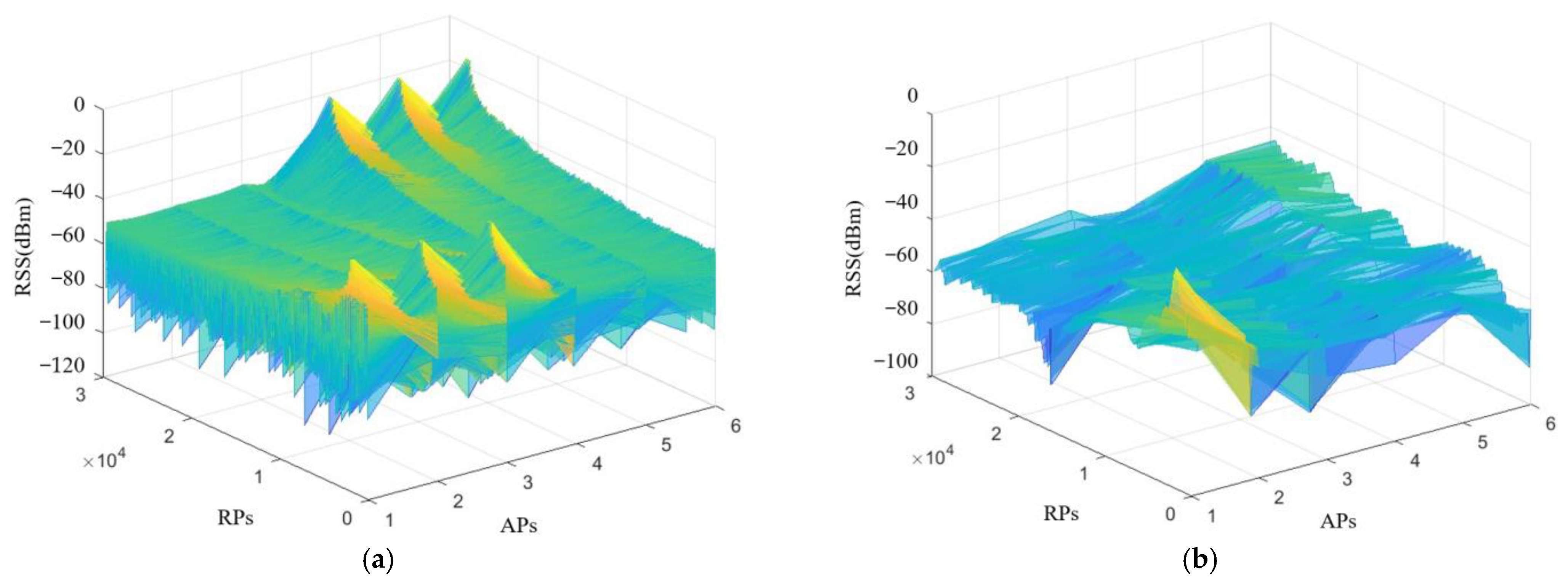
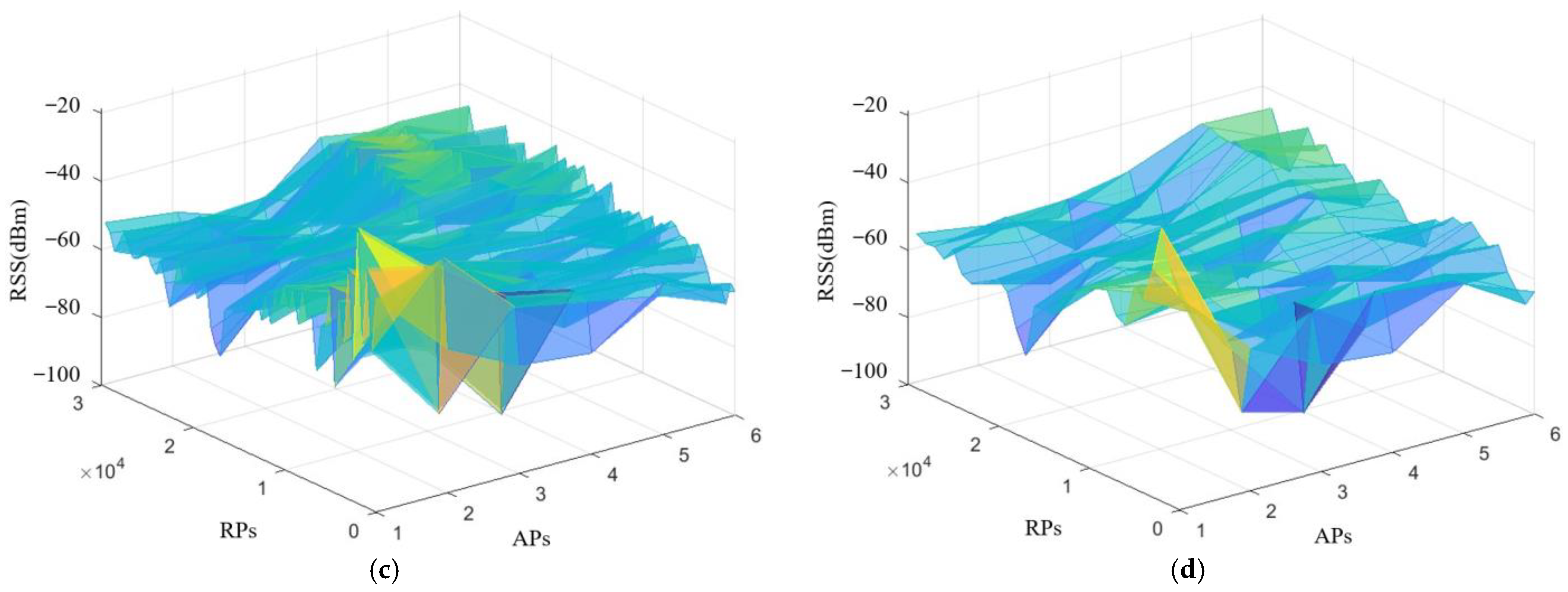
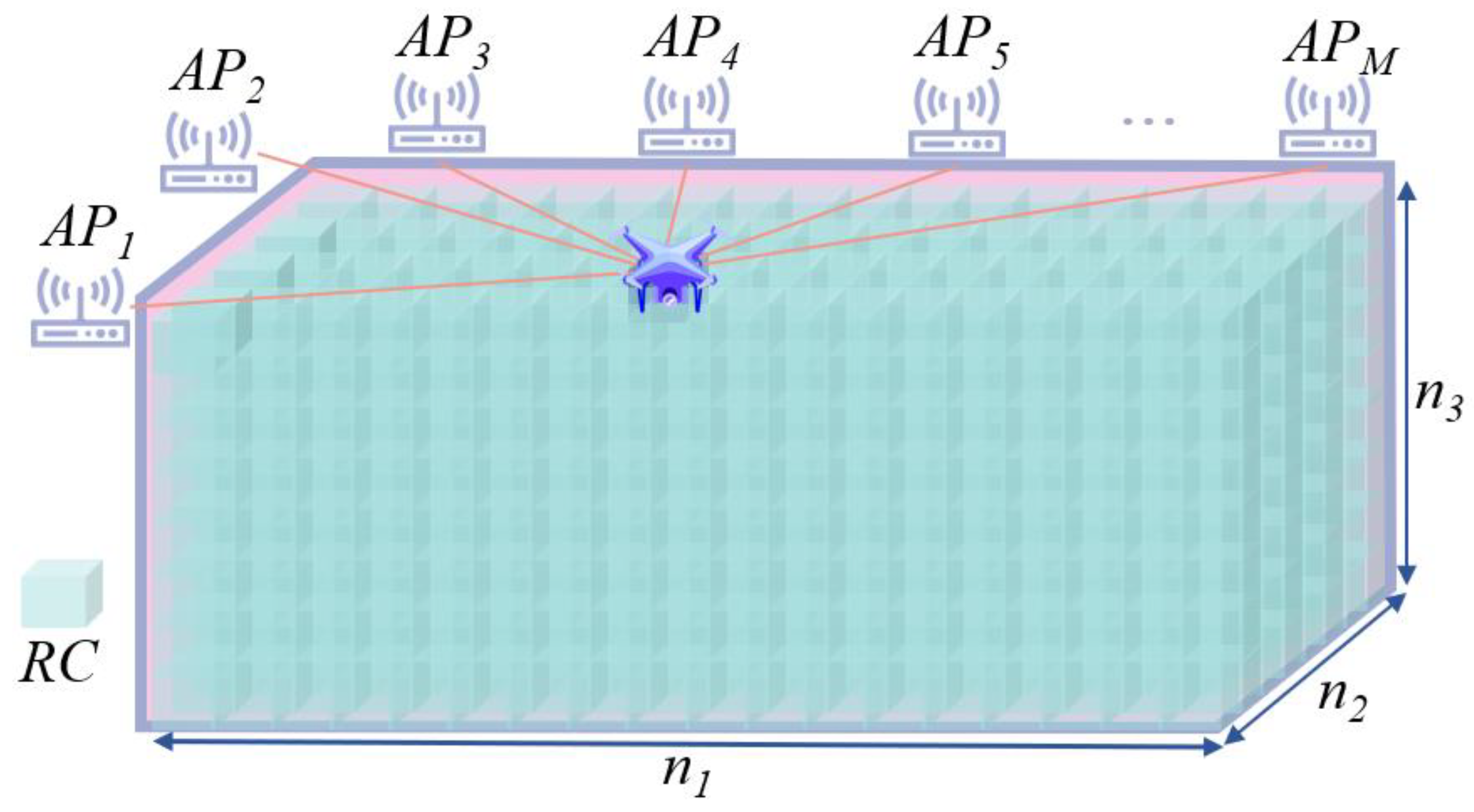


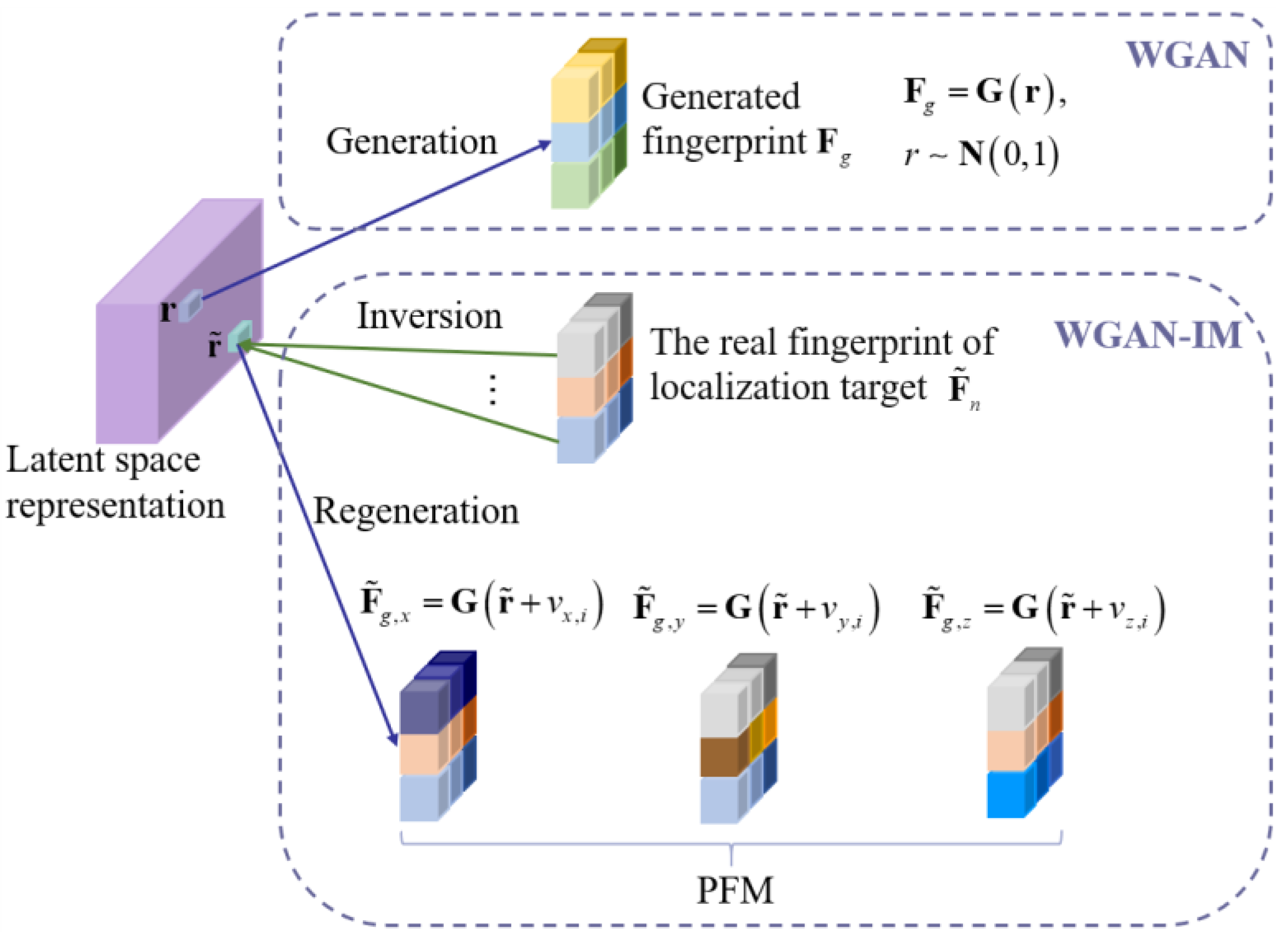
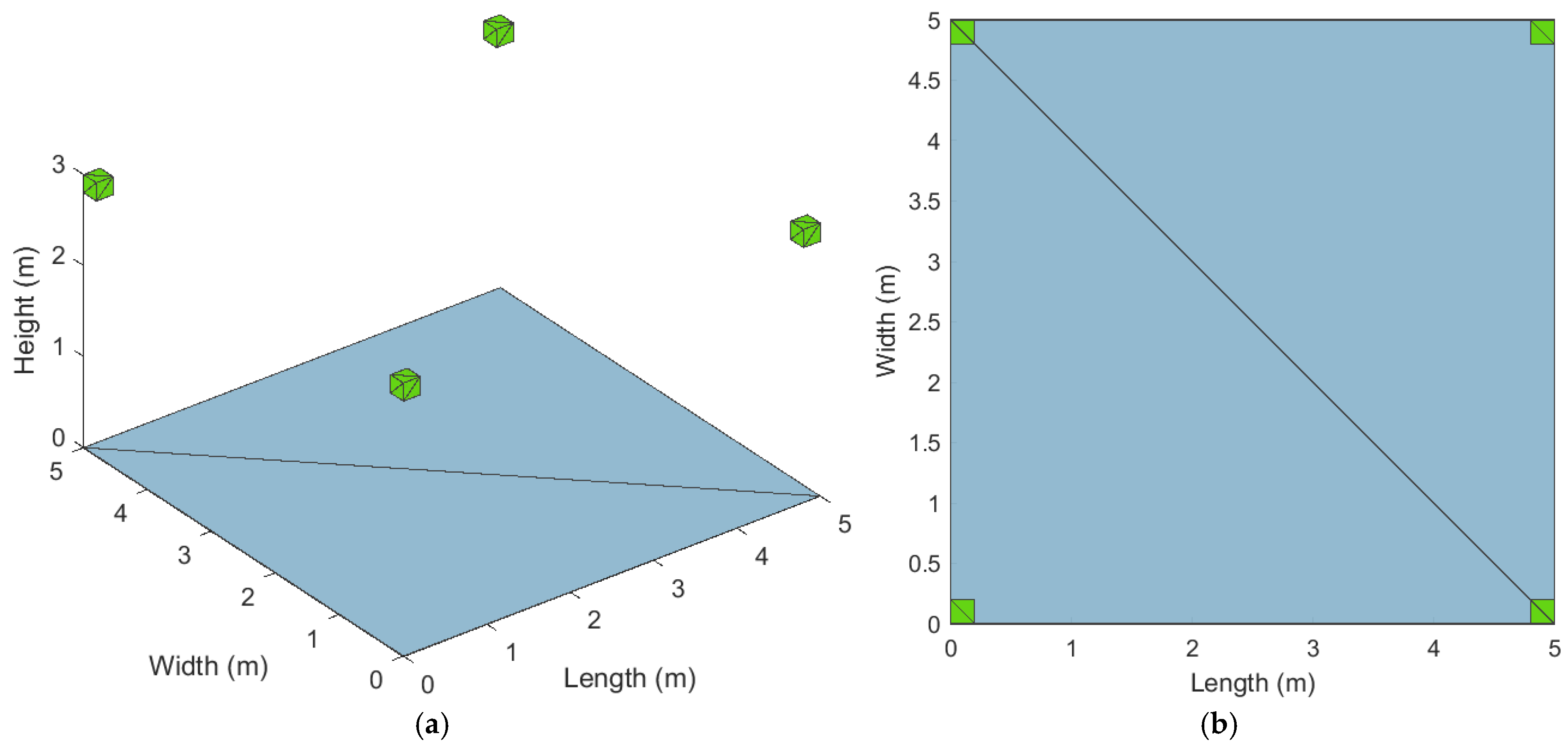
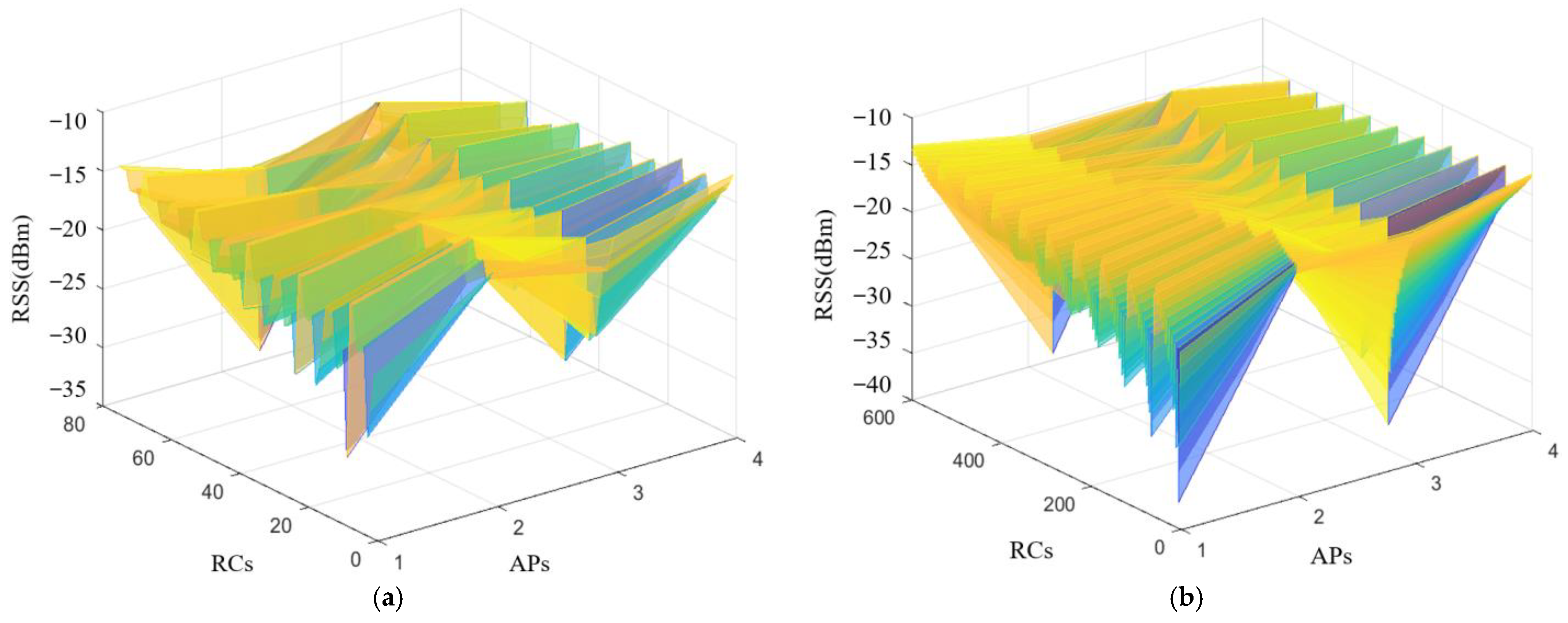

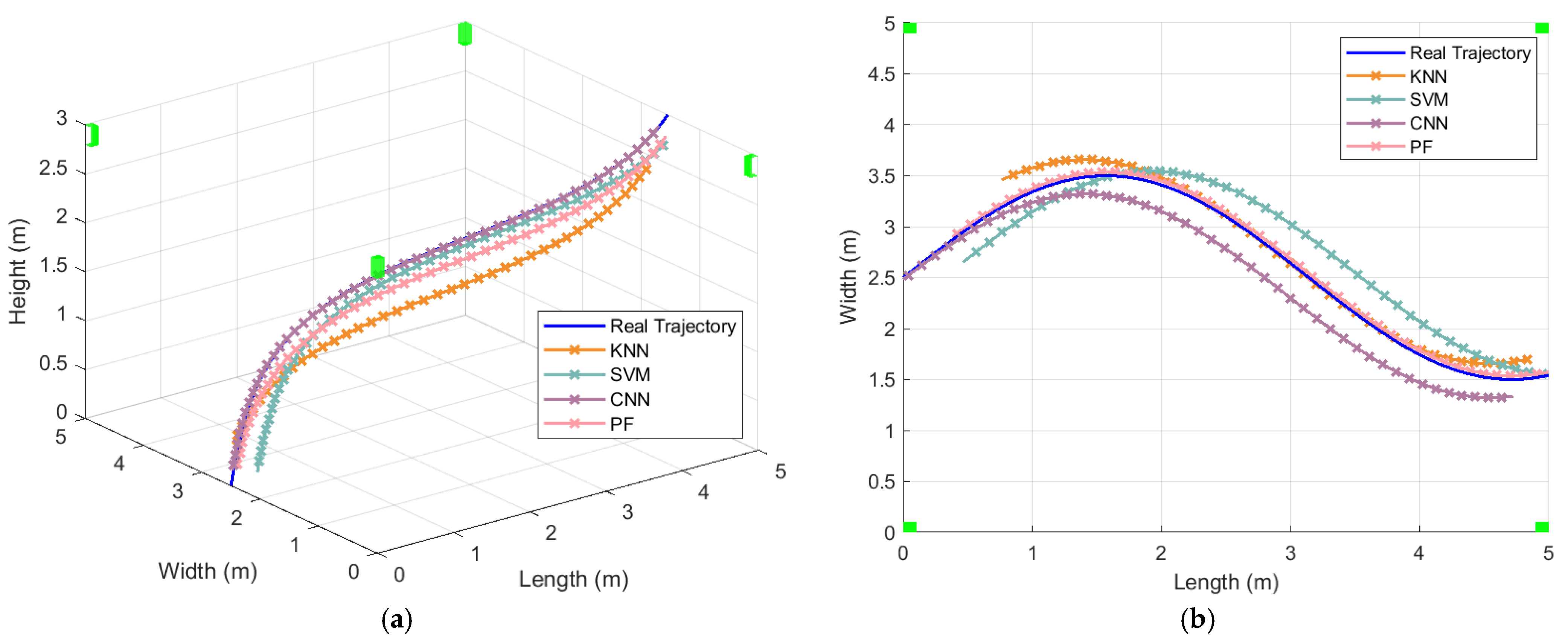
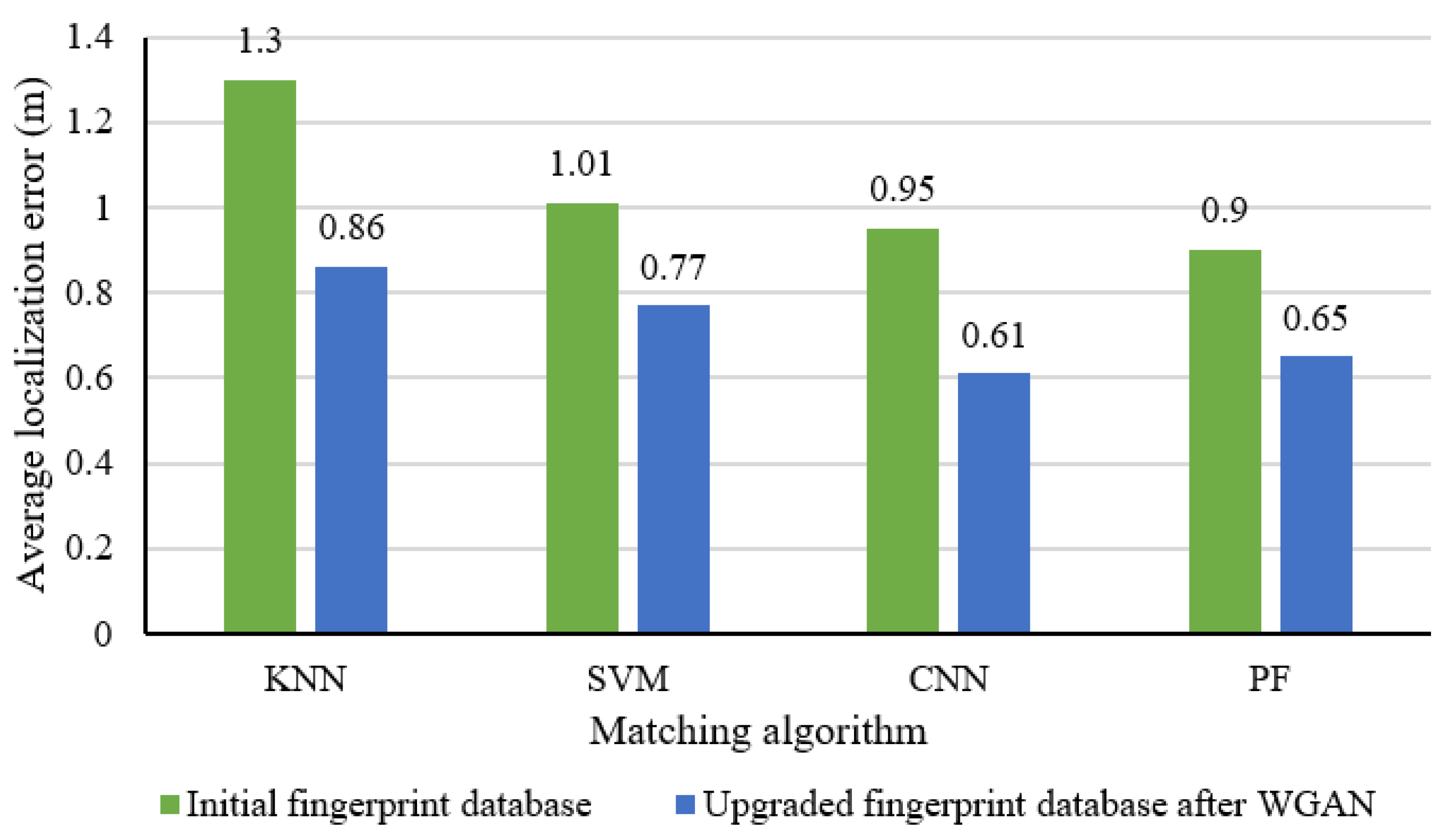

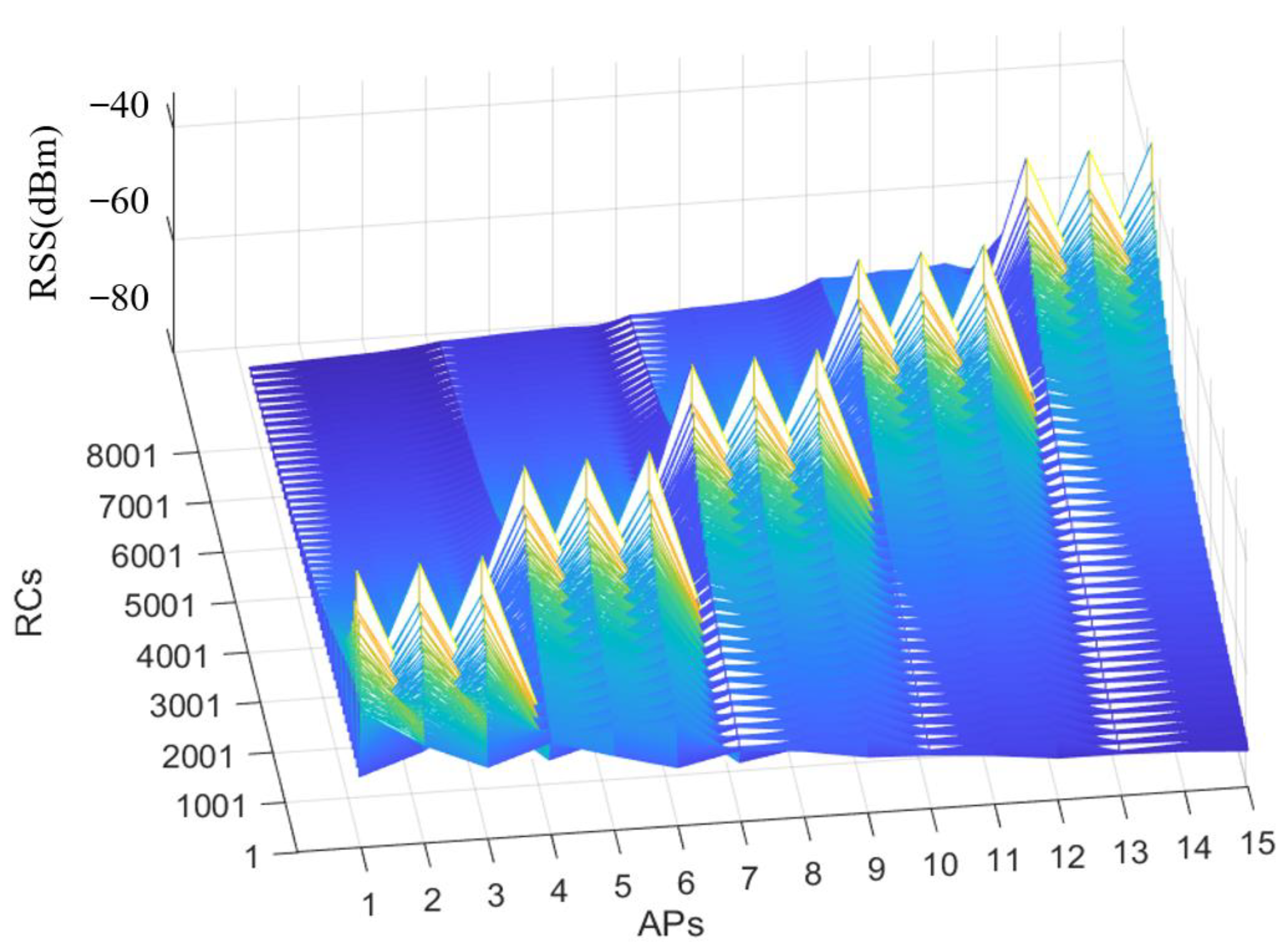
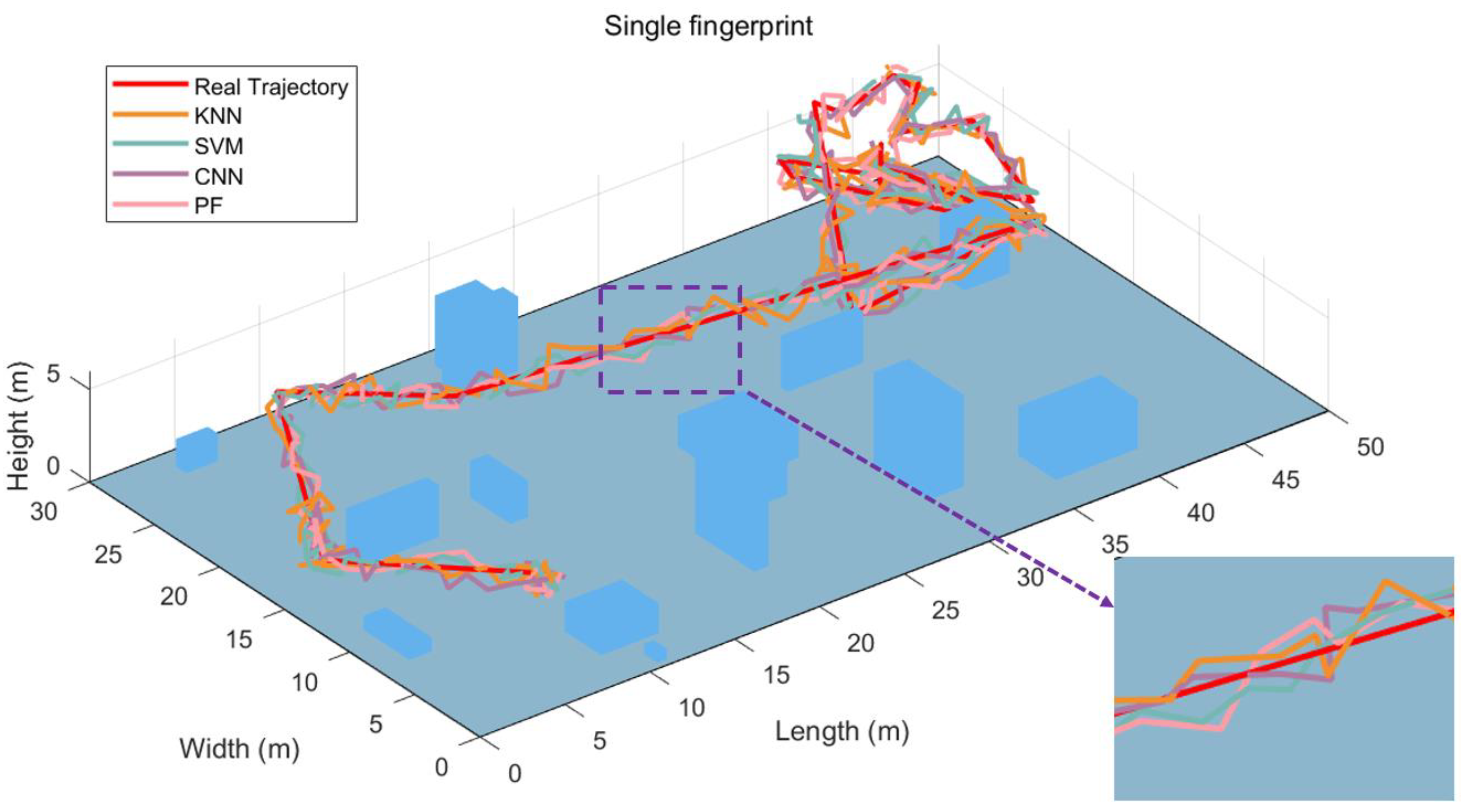

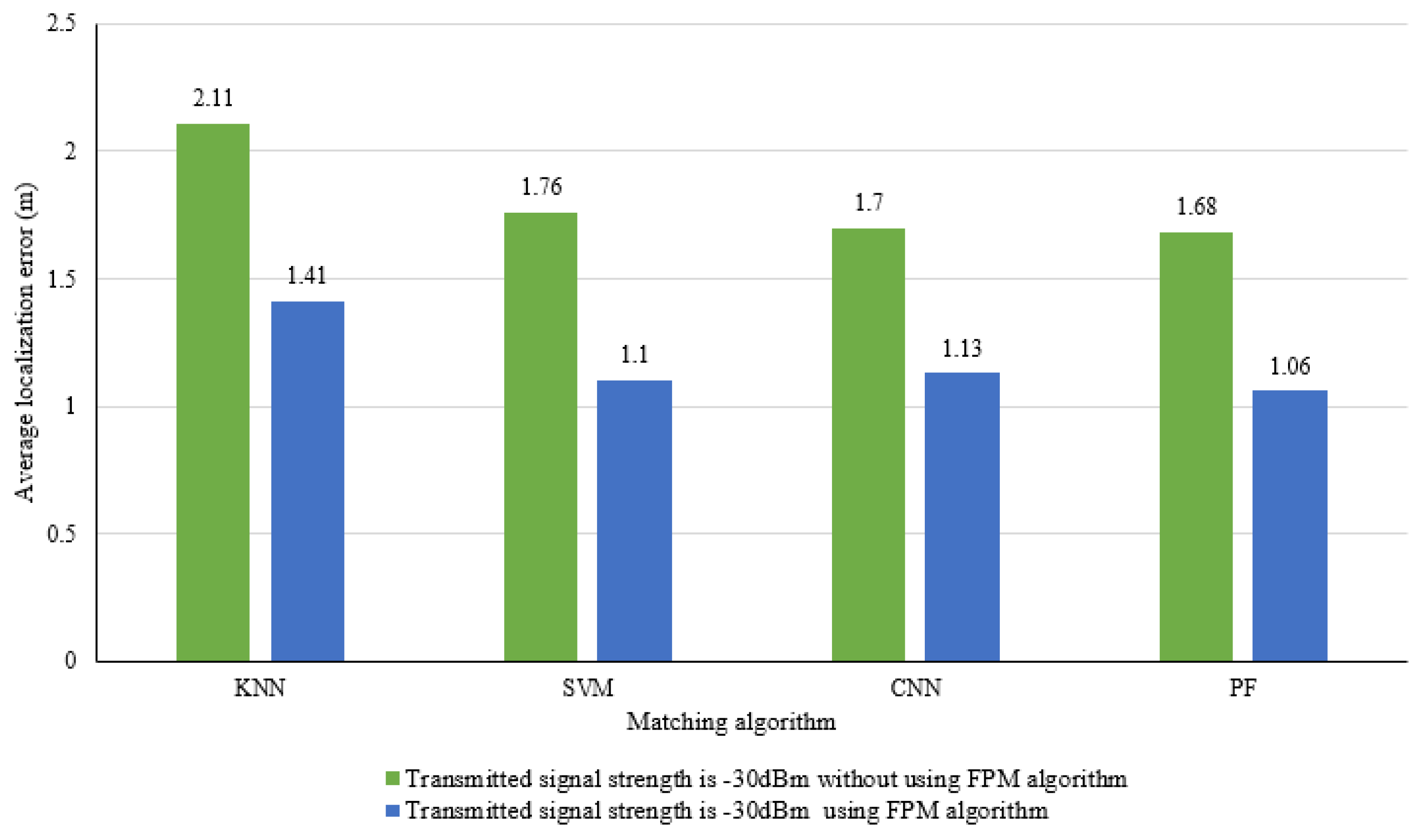
| Phase | Task | Function |
| Training | Train WGAN using existing data | WGAN’s generator learns the statistical distribution of simulated data. |
| Generate new sample | Create new data sample | The new samples are created based on the learned data distribution, helping to fill in the uncovered data space areas. |
| Increase diversity | Import generator via different noise vectors | Generate a variety of new samples, enrich the diversity of data, and help the model learn a wider range of features and patterns. |
| Avoid overfitting | Use data augmentation | Prevent model overfitting and improve model training effect. |
| Improve accuracy | Training model | Data generated through WGAN improve model accuracy. |
| Parameter | Transmitter Frequency | Transmitting Amplitude | Router Coordinates | Simulation Environment | Sampling Interval | Initial Fingerprint RCs | Upgraded Fingerprint RCs | Number of Algorithms (K) | ||
|---|---|---|---|---|---|---|---|---|---|---|
| Value | 2.4 GHz, 5 GHz | −10 dBm | (0, 0, 3), (0, 5, 3), (5, 5, 3), (5, 0, 3) | 5 × 5 × 3 | 1 m | 75 | 600 | 1 m/s | 20 | 0.5 s |
| Description | Signals generated by Wi-Fi routers | Wi-Fi signal amplitude | Positions in meters | Size of the indoor environment | RC is 1 × 1 × 1 | Number of initial fingerprint RCs | Number of RCs after WGAN upgrade | UAV’s speed | Number of classic matching algorithms | Time interval for UAV trajectory |
| Parameter | Transmitter Frequency | Transmitting Amplitude | Number of Tests | Simulation Environment | RC Size | Number of Obstacles | Number of Algorithms (K) | |||
|---|---|---|---|---|---|---|---|---|---|---|
| Value | 2.4 GHz, 5 GHz | −10 dBm | 1000 | 50 × 30 × 6 | 1 m | 9000 | 15 | 1 m/s | 20 | 0.5 s |
| Description | Signals generated by Wi-Fi routers | Wi-Fi signal amplitude | Tests conducted to verify PFM algorithm performance | Size of the indoor environment | Each RC is a cube with a side length of 1 m | Total number of RCs after WGAN expansion | Fixed number of obstacles | UAV’s speed | Number of classic matching algorithms | Time interval for UAV trajectory |
| Algorithm | Localization Error (m, without PFM) | Localization Error (m, with PFM) | Computational Complexity (Time, Memory) | Environmental Adaptability (Error Reduction %) | Robustness (Performance under Perturbations) |
|---|---|---|---|---|---|
| KNN | 2.11 | 1.41 | 12 ms,100 MB | 2.2% | 85% |
| SVM | 1.76 | 1.1 | 21 ms, 200 MB | 2.8% | 90% |
| CNN | 1.7 | 1.13 | 36 ms, 500 MB | 2.7% | 92% |
| PF | 1.68 | 1.06 | 52 ms, 800 MB | 7.1% | 95% |
Disclaimer/Publisher’s Note: The statements, opinions and data contained in all publications are solely those of the individual author(s) and contributor(s) and not of MDPI and/or the editor(s). MDPI and/or the editor(s) disclaim responsibility for any injury to people or property resulting from any ideas, methods, instructions or products referred to in the content. |
© 2024 by the authors. Licensee MDPI, Basel, Switzerland. This article is an open access article distributed under the terms and conditions of the Creative Commons Attribution (CC BY) license (https://creativecommons.org/licenses/by/4.0/).
Share and Cite
Yang, J.; Tian, J.; Qi, Y.; Cheng, W.; Liu, Y.; Han, G.; Wang, S.; Li, Y.; Cao, C.; Qin, S. Research on 3D Localization of Indoor UAV Based on Wasserstein GAN and Pseudo Fingerprint Map. Drones 2024, 8, 740. https://doi.org/10.3390/drones8120740
Yang J, Tian J, Qi Y, Cheng W, Liu Y, Han G, Wang S, Li Y, Cao C, Qin S. Research on 3D Localization of Indoor UAV Based on Wasserstein GAN and Pseudo Fingerprint Map. Drones. 2024; 8(12):740. https://doi.org/10.3390/drones8120740
Chicago/Turabian StyleYang, Junhua, Jinhang Tian, Yang Qi, Wei Cheng, Yang Liu, Gang Han, Shanzhe Wang, Yapeng Li, Chenghu Cao, and Santuan Qin. 2024. "Research on 3D Localization of Indoor UAV Based on Wasserstein GAN and Pseudo Fingerprint Map" Drones 8, no. 12: 740. https://doi.org/10.3390/drones8120740
APA StyleYang, J., Tian, J., Qi, Y., Cheng, W., Liu, Y., Han, G., Wang, S., Li, Y., Cao, C., & Qin, S. (2024). Research on 3D Localization of Indoor UAV Based on Wasserstein GAN and Pseudo Fingerprint Map. Drones, 8(12), 740. https://doi.org/10.3390/drones8120740







